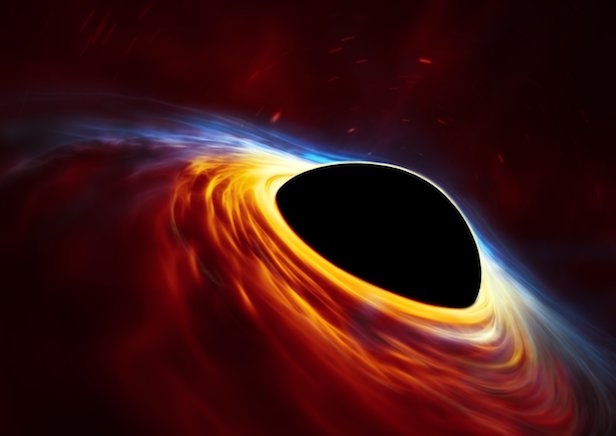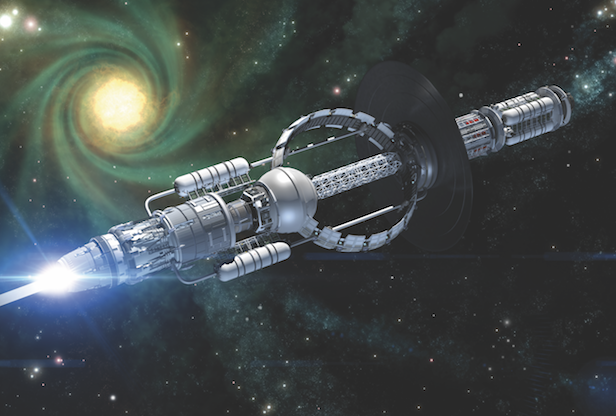Future Tech: Can black holes be used to power interstellar spacecraft?
Space flight between the stars will need a tremendous amount of energy – and we may be able to store it in a miniature black hole
Interstellar distances are difficult to conceive. Our nearest star is Proxima Centauri, a red dwarf 4.3 light years away. That’s more than 266,000 times the distance from Earth to the Sun and if our fastest spacecraft, Voyager 1, which is flying at 18 kilometres (11 miles) per second, were headed that way it would still take 80,000 years to get there. For humans to be able to explore the galaxy we are going to need another way to travel, but while the focus has been on the propulsion side of the puzzle, equally challenging is how we power such journeys. But there’s a strange concept that might solve both problems: the Schwarzschild Kugelblitz, a craft powered by a black hole.
To make interstellar journeys in a reasonable time we will have to achieve a good per cent of the speed of light (300,000,000 metres or 984,252,000 feet per second). For every kilogram (2.2 pounds) of mass that makes up the composition of a spacecraft and its payload, when travelling at 99.9 per cent the speed of light it will have a kinetic energy more than six times that contained in the 1961 Tsar Bomba, the largest nuclear weapon ever detonated. All this energy must be safely stored in a form that can be built into a spacecraft, and supplied to the prospective starship without destroying it.
Writing in 1955, American physicist John Wheeler (believed to have coined the terms ‘black hole’, ‘wormhole’ and ‘quantum foam’) proposed that if enough energy could be concentrated into a small space, the energy would form a microscopic black hole. He nicknamed this concept the Kugelblitz – meaning ‘ball lightning’ in German – and as a black hole is defined by being mass-energy squashed so that its gravity won’t let light escape, compressed within the Schwarzschild radius, it has become known as the Schwarzschild Kugelblitz.

Could black holes be used as a power source for interstellar travel? Image credit: European Southern Observatory
Counterintuitively, black holes actually produce radiation; it was first proposed by Stephen Hawking in 1974 that when quantum fluctuations happen next to the horizon of a black hole, it leads to the creation of two particles, but instead of the particles annihilating each other, one gets sucked into the black hole letting the other escape. Because of the conservation of energy, this process uses up energy from the black hole, and unless it sucks in more stuff, this Hawking radiation will eventually cause it to evaporate. This effect would be even more pronounced with a Kugelblitz micro-black hole, enabling us to extract energy from it. A practical Kugelblitz will be a balancing act – it must be small enough that it makes enough Hawking radiation, light enough that a spacecraft carrying it can accelerate it, but big enough to last long enough to be useful. Such a Kugelblitz would be smaller than a proton, yet have a mass of 606,000 tons, and would produce 160 petawatts (over 10,000 times the power consumption of humanity) for 3.5 years.
The simplest option for using this power source would be to place it at the focus of a vast parabolic reflector and use this to make a beam of Hawking radiation to push the craft along. While this approach is simple, it wouldn’t make good use of the Kugelblitz’s power; it would only be able to reach four per cent of light speed before the Kugelblitz evaporated. A more challenging but efficient option would be to enclose the Kugelblitz in a spherical shell, capturing all of its energy and using this to drive a heat engine of some sort. Assuming 100 per cent energy efficiency, this could accelerate a craft to ten per cent of light speed in 20 days. The engineering challenges are huge, but the Kugelblitz is the most compact energy source ever conceived, even over anti-matter. Perhaps one day it will be powering humanity across the stars.
Keep up to date with the latest news in All About Space –available every month for just £4.99. Alternatively you can subscribe here for a fraction of the price!





